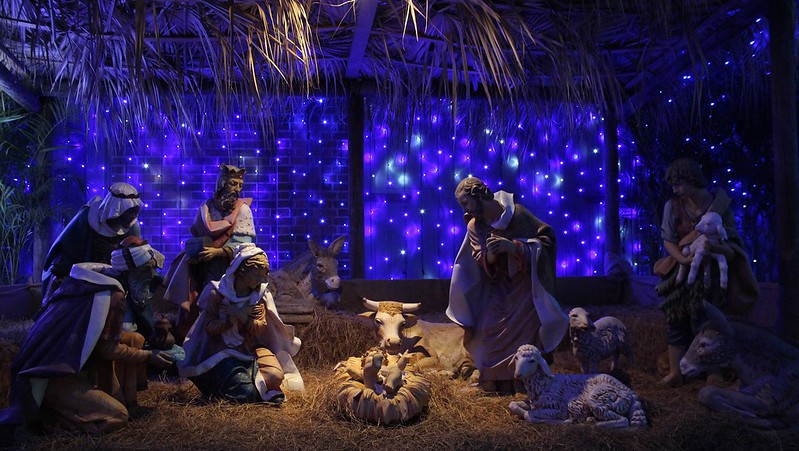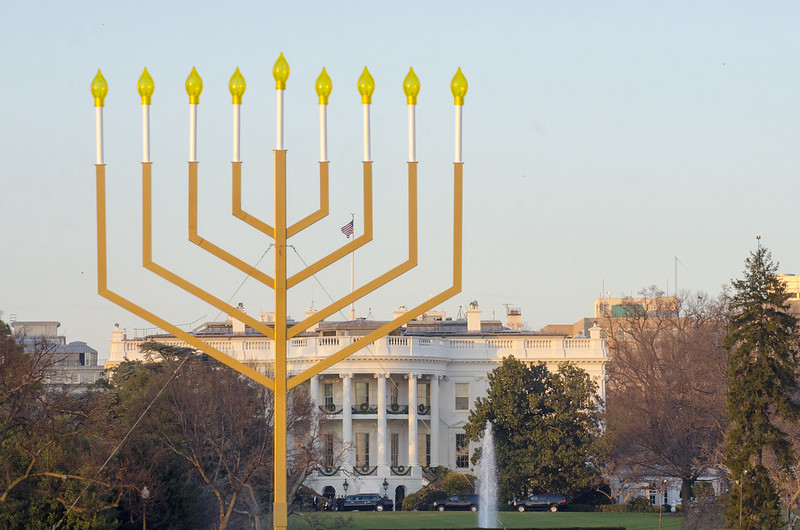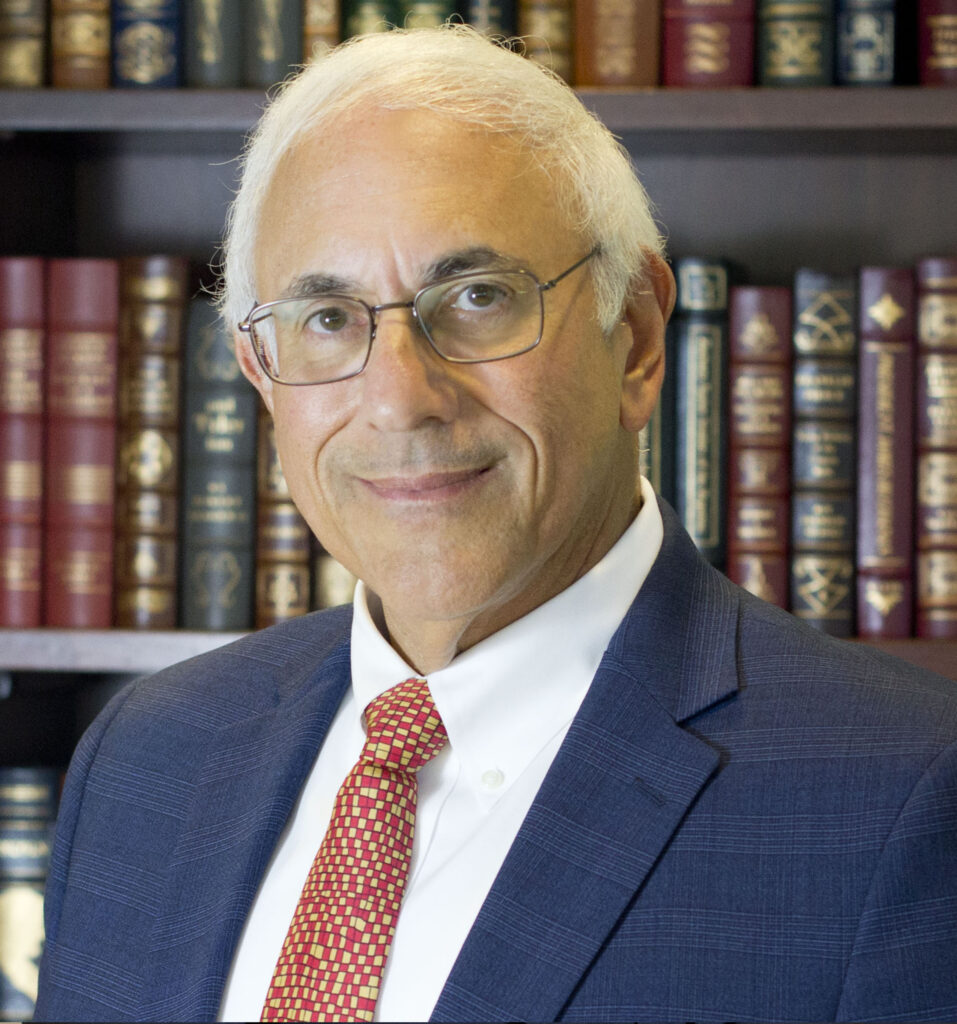Santa is Welcome, but Be Careful About Religious Displays
Guest blog by Donald Scarinci
Santa Claus can always come to town during the holidays, but the religious symbols accompanying the holiday season are not always welcome. In most cases, the First Amendment does not play Scrooge to festive decorations. However, like many constitutional issues, court decisions have made the law a bit murky.
While Christmas trees, colored lights, reindeer, and snowmen will always get the green light, there is no clear answer regarding religious displays, such as nativities and menorahs, on public property. However, based on existing precedent, a holiday display featuring symbols from different religions and secular symbols of the holidays is likely constitutional.

Christmas display at the Osborne Family Spectacle of Dancing Lights at Disney’s Hollywood Studios, Orlando, Florida. 2015. Chad Sparkes.
The Establishment Clause
The First Amendment’s Establishment Clause governs most constitutional issues involving holiday displays. The Establishment Clause provides:
“Congress shall make no law respecting an establishment of religion, or prohibiting the free exercise thereof.”
It is a common misconception that the Constitution requires a wall of separation between church and state. As the U.S. Supreme Court explains, the Establishment Clause does not “require complete separation of church and state; it affirmatively mandates accommodation, not merely tolerance, of all religions, and forbids hostility toward any.”
In short, this means that municipalities and other public agencies can’t erect holiday displays favoring one religious sect over another or conveying an endorsement of religion altogether. However, government entities are allowed to incorporate religious symbols into holiday displays.

The National Menorah near the White House in Washington, D.C. Photo by Tim Brown
The Incorporation of Religion into Holiday Displays
The constitutionality of government-erected holiday displays depends on the circumstances, such as the display’s context and content. Some will pass muster, while others will not.
Courts have acknowledged that while Christmas trees have their roots in Christianity, they are now largely considered secular. As explained by the Supreme Court, “Although Christmas trees once carried religious connotations, today they typify the secular celebration of Christmas…Numerous Americans place Christmas trees in their homes without subscribing to Christian religious beliefs, and when the city’s tree stands alone in front of the City-County Building, it is not considered an endorsement of Christian faith.”
As for decorations with clear ties to religion, such as a menorah or crèche, the Supreme Court has developed a few legal tests. For example, in Lynch v. Donnelly, 465 U.S. 668, 686 (1984), the Supreme Court upheld the constitutionality of a nativity display on government property because it was a part of a larger holiday display that included various secular symbols.
As the Court explained:
It would be ironic . . . if the inclusion of a single symbol of a particular historic religious event, as part of a celebration acknowledged in the Western World for 20 centuries, and in this country by the people, by the Executive Branch, by the Congress, and the courts for 2 centuries, would so “taint” the city’s exhibit as to render it violative of the Establishment Clause. To forbid the use of this one passive symbol—the crèche—at the very time people are taking note of the season with Christmas hymns and carols in public schools and other public places, and while the Congress and legislatures open sessions with prayers by paid chaplains, would be a stilted overreaction contrary to our history and to our holdings.
The Supreme Court’s subsequent decision in Allegheny v. ACLU, 492 U.S. 573 (1989), demonstrates how much context matters, as it reached separate conclusions on two challenged holiday displays. First, the Court ruled that a crèche inside a Pennsylvania courthouse, which also featured the words “Glory to God for the birth of Jesus Christ,” had the “unconstitutional effect of conveying a government endorsement of Christianity.”
In reaching its decision, the Court relied on the “endorsement” test advocated by Justice Sandra Day O’Connor in her concurrence in Lynch, under which government endorsement or disapproval of religion is unconstitutional. “No viewer could reasonably think that it occupies this location without the support and approval of the government,” the Court wrote. “Thus, by permitting the ‘display of the crèche in this particular setting,’ the county sends an unmistakable message that supports and promotes the Christian praise to God that is the creche’s religious message.”
However, the Court further held that not all religious displays run afoul of the Establishment Clause, emphasizing that each display must be evaluated as a whole. For example, with regard to a second display featuring a menorah, the justices held that the addition of Christmas trees and other secular holiday decorations rendered it constitutional. According to the Court, the “city’s overall display must be understood as conveying the city’s secular recognition of different traditions for celebrating the winter-holiday season.”
Lower courts have reached similar conclusions. In ACLU v. Schundler, 168 F.3d 92 (3d Cir. 1999), the Third Circuit Court of Appeals considered the constitutionality of two Jersey City holiday displays. The first, which featured a menorah and a Christmas tree, was forbidden. A modified display, however, did pass muster. It contained not only a crèche, a menorah, and a Christmas tree but also large plastic figures of Santa Claus and Frosty the Snowman, a red sled, Kwanzaa symbols on the tree, and signs stating that the display was one of a series of displays put up by the City throughout the year to celebrate its residents’ cultural and ethnic diversity. According to the Third Circuit, the modified display was “indistinguishable in any constitutionally significant respect” from the displays upheld by the Supreme Court in Lynch and Allegheny.
Key Takeaway
Not surprisingly, questions about the constitutionality of holiday displays arise every year. Complaints from the public (and the occasional lawsuit) are also not uncommon. While the Supreme Court has not established a bright-line rule, its decisions confirm that displays that exclusively or prominently display religious symbols will likely run afoul of the First Amendment. On the other hand, an eclectic mix of holiday favorites like reindeer and Christmas trees, along with religious items, is generally a winning combination of holiday cheer.

About the author
Donald Scarinci is the Founding Partner of Scarinci Hollenbeck. He writes and lectures extensively about Constitutional Law and edits the award-winning, The Constitutional Law Reporter. His practice focuses on representing public institutions and businesses that interact with government.

